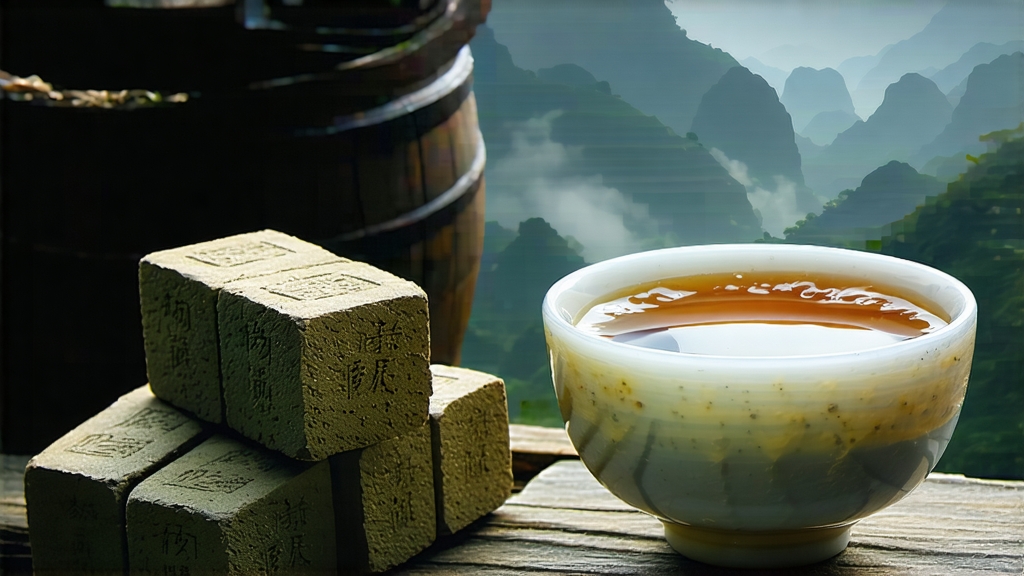
Tucked away in the humid, karst-dotted mountains of southern China’s Guangxi Zhuang Autonomous Region, Liu Bao tea has spent four centuries quietly perfecting the art of transformation. Unlike the better-known Pu-erh that hogs the limelight, Liu Bao is the insider’s dark tea—an earthy, mellow liquor that improves for decades when kissed by gentle heat and time. To international drinkers who equate “black tea” with British breakfast blends, Liu Bao offers a revelation: here is a tea that is literally alive, whose flavor profile can migrate from mossy forest floor to dark cocoa, from camphor to dried longan, all without a single artificial additive.
Historical footprints
The story begins during the Qing dynasty’s Kangxi reign (1662–1722), when Liu Bao village—then a staging post on the Tea-Horse Road—was ordered to send “mountain tribute tea” to the imperial court. Caravans carrying bulky bamboo-bound baskets of compressed leaves traveled down the Liu River to the Pearl Delta, then onward to Hong Kong and Southeast Asia. Dockworkers in Singapore and Kuala Lumpur noticed that the tea tasted smoother after the hot, damp voyage; Chinese medicine shops began stocking it as a digestive tonic for tin-mine laborers. By the 1950s Liu Bao had become a currency of the Chinese diaspora: a single thirty-kilogram basket could pay a carpenter’s wage for a month in Malaya. When China’s domestic market pivoted to green tea in the 1980s, Liu Bao almost vanished; only the relentless demand of Malaysian collectors kept the kilns firing. Today, as wellness culture meets connoisseurship, a 1980s “three-flower” branded Liu Bao cake can fetch the price of a single-malt Scotch at auction in Guangzhou.
Terroir and leaf
Guangxi’s subtropical climate—year-round humidity above 75 %, mean temperature 22 °C—creates an ideal microbial playground. The indigenous large-leaf variety, Camellia sinensis var. assamica, grows on red lateritic soils at 300–800 m elevation. Old-garden trees, some topping three metres, develop thick leaves rich in polyphenols and pectin, the very compounds that later feed the beneficial molds and yeasts responsible for Liu Bao’s mellow character. Farmers pluck one bud with three to four leaves in late April, after the spring rains have swollen the shoots but before the fibres toughen.
Crafting the darkness
Liu Bao belongs to the “post-fermented” category: fermentation does not stop when the leaves leave the factory; it continues in the cup, the jar, even your stomach. The traditional roadmap has seven steps, each a dialogue between human intention and microbial whim.
- Solar withering: Fresh leaves are spread on bamboo mats under morning sun for 2–3 hours, softening cell walls and initiating enzymatic oxidation.
- Indoor piling: Leaves are heaped 30 cm deep in humid rooms for 12 hours, reaching 40 °C; this “yellowing” phase reduces grassy notes and develops a faint apricot aroma.
- Kill-green: A short 3-minute roast at 200 °C in a rotating drum deactivates leaf enzymes but preserves microbes clinging to the surface.
- Rolling: Light pressure for 8 minutes breaks epidermal cells, prepping the leaf for microbial colonisation without shredding it.
- Primary drying: Hot-air tunnels drop moisture to 18 %, stabilising the leaf for the pivotal next act.
- Wet piling (wo dui): Unique to Liu Bao, 100 kg batches are sprayed with mountain spring water, covered with hemp sacks, and left in a 28 °C, 85 % humidity room for 25–35 days. Thermophilic molds (Aspergillus, Rhizopus) bloom, converting catechins into theaflavins and gallic acid, yielding the signature “betel-nut” fragrance. Masters gauge readiness not by calendar but by aroma: when the pile smells of damp moss and jaggery, it is time.
- Steam compression & basket firing: The fermented leaf is steamed for 30 seconds, pressed into cylindrical bamboo baskets lined with wild taro leaves, then slow-dried for three days over a gentle charcoal fire made from local banyan wood. The